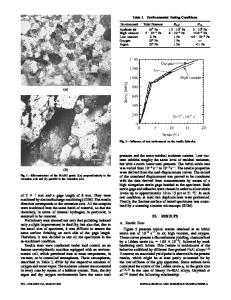Effect of loading rate on fracture behaviors of shale under mode I loading
- PDF / 2,847,346 Bytes
- 15 Pages / 595.22 x 842 pts (A4) Page_size
- 24 Downloads / 366 Views
Effect of loading rate on fracture behaviors of shale under mode I loading XIE Qin(谢秦)1, LI Sheng-xiang(李生相)1, LIU Xi-ling(刘希灵)1, GONG Feng-qiang(宫凤强)2, LI Xi-bing(李夕兵)1 1. School of Resources and Safety Engineering, Central South University, Changsha 410083, China; 2. School of Civil Engineering, Southeast University, Nanjing 211189, China © Central South University Press and Springer-Verlag GmbH Germany, part of Springer Nature 2020 Abstract: In this study, the effect of loading rate on shale fracture behaviors was investigated under dynamic and static loading conditions. Cracked straight through Brazilian disc (CSTBD) shale specimens were tested with a split Hopkinson pressure bar (SHPB) setup and INSTRON1346 servo-testing machine under pure mode I loading conditions. During the test, the crack propagation process was recorded by high-speed (HS) camera, and the acoustic emission (AE) signal generated by the fracture was collected by acoustic emission (AE) system. At the same time, crack propagation gauge (CPG) was used to measure the crack propagation velocity of the specimen. The results show that the crack propagation velocity and fracture toughness of shale have a positive correlation with the loading rate. The relationship among the crack propagation velocity, the fracture toughness and the loading rate is established under the static loading condition. In addition, the characteristics of AE signals with different loading rates are analyzed. It is found that the AE signals generated by microcrack growth decrease with the increase of loading rates. Meanwhile, the turning point of cumulative counting moves forward as the loading rate increases, which shows that the AE signal generated by shale fracture at low loading rate mainly comes from the initiation and propagation of microcracks, while at high loading rate it mainly comes from the formation of macro large-scale cracks. The fracture mechanism that causes shale fracture toughness and crack propagation velocity to vary with loading rate is also discussed based on the analysis results of AE signals. Key words: shale; loading rate; cracked straight through Brazilian disc; fracture toughness; acoustic emission; crack propagation velocity Cite this article as: XIE Qin, LI Sheng-xiang, LIU Xi-ling, GONG Feng-qiang, LI Xi-bing. Effect of loading rate on fracture behaviors of shale under mode I loading [J]. Journal of Central South University, 2020, 27(10): 3118−3132. DOI: https://doi.org/10.1007/s11771-020-4533-5.
1 Introduction It is well known that the loading rate is one of the most important factors affecting the mechanical properties of rock materials. A large number of research results have shown that it will enhance the strength of rock as the loading rate increases [1−5]. However, there are many micro-defects or fissures inside in the process of geological evolution of natural rocks. The process of rock fracture and
instability is completed by internal micro-cracks under a certain loading condition through initiation, crack propagation, connection and for
Data Loading...











